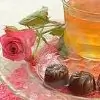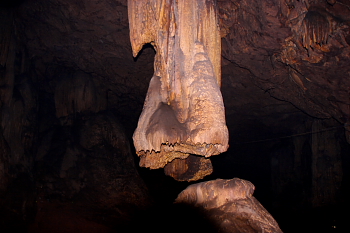As per the writings on the temple wall this temple is believed to be constructed by the King Pulakesi II of Chalukya dynasty around 625 A.D to commemorate his victory over Vengi region of Andhra Desham. This can be observed from the square pillars used in the temple structure which were different from the circular pillars commonly used in temples constructed by Kakatiyas.
The Kakatiya kings of "Orugallu empire" which is the present Warangal town have adopted Goddess Bhadrakali as their "Kula Devatha" giving her preference over other gods. The lake was built later by Ganapathi Deva, a minister in Kakatiya Dynasty. A road leading to the temple was also added during that period.
Due to the fall of Kakatiya Dynasty to the Muslim ruler of Delhi Ala-ud-din Khilji, his general Malik Kafur and later to Ghias-ud-Din Tughlak, and during the rule of Bahamani Sultans and Golkonda rulers, the temple lost its prominence over the period and the place has become dilapidated.
Sri Ganapathi Sastri (a.k.a. B. S. Ganesh Rao) a Brahmin and devi upasaka (Devotee of Goddess Kali) from Karnataka has migrated to Warangal in 1940's. He noticed the old Bhadrakali temple and has taken interest in renovating the temple. He constructed a small house next to the temple and started living in this isolated place. He along with Sri Mudumbai Ramanujacharya sought the help of Sri Maganlal Sameja (a prominent local merchant) and other affluent locals and renovated the old temple in 1950. Many persons like Brahmasri Sri Hari Radhakrishnamurthy, Adluri Seetharama Shastry, Vangala Guravaiah, Thandra Venkata Rama Narsaiah, Mahatapaswini Mangalambika and Tankasala Narasimha Rao have lent their hands in the renovation work of the temple.
Before the temple was renovated in 1950 there were Animal Sacrifices at the temple (an old custom at Kali temples in India). This practice was stopped from 1950 onwards after the renovation of the temple. During the renovation, Chandi yantra was installed in the temple and amrutha beejaksharas (holy shlokas) were written on the deity's hanging tongue and modified the deity's fierce looking eyes and tongue to a pleasant looking face. Since then everyday poojas, Sharannavaratras, Vasantha navarathras are being conducted regularly as per the Vedic rites.
Sri Ganapathi Sastri, at the age of 113, died on 11 November 2011 in Warangal. He was survived by two sons and three daughters. He was the Bhadrakali's temple trustee at the time of his death. The temple and the people of Warangal has lost a great man who has developed the temple single handedly. His son Sri B. Seshagiri Rao has taken over the temple affairs as chief priest a few years ago.
ABOUT TEMPLE :-
The temple's main deity Goddess Bhadrakali's image is made in a 2.7x2.7 meters square stone facing west with pleasant looking eyes holding weapons in her eight hands with Shiva under her feet. 'Sree Chakram' and 'Utsava Vigrahas' of Bhadrakali are placed in front of the main deity.
A statue of Lion, Bhadrakali's vahana on which she rides, is placed opposite the sanctum sanctorum. The temple also has a Dhwaja Sthambam and Balipeetham.
Some of the oldest deities in the Maha Mantapam along with Bhadrakali are Uma Maheshwara images on stone in front of Shiva Linga, Subramanya Swamy statue, Hanuman statue and Navagrahas all carved in stone.
A new road was constructed in 1966 from the temple to the Warangal-Kazipet main road next to Government Polytechnic. The temple has been expanded in the 2000s with the addition of Alaya Shikaram, Maha Mantapam. Recently Sri Vallabha Ganapathi temple and temple parikrama have been added to the main temple.
The temple management is also running a Veda Pathasala (School for learning Vedas) near the temple.
There are 8 major and 12 minor temples in the mountains surrounding the Bhadrakali Temple including Padmakshi temple, Sri Shirdi Sai Baba, Sri Narasimha swamy temple and Sri Pothuluri Veerabrahmendra Swamy temple.
Bhadrakali Temple has become a major tourist place and people from many parts of India visit this temple.
MAJOR ATTRACTIONS :-
The high point of Bhadrakali Temple is the lake adjoining the temple. The lake has a capacity of 160 million cubic feet (mcft). Earlier rain was the only source of water for this lake and during drought season the lake gets dried up completely. About 20 years ago pipelines were laid from Kakatiya Canal which brings water from Manair Dam in Karimnagar District and now the lake is full throughout the year. Bhadrakali lake is now used as one of the source of drinking water for Warangal and Hanamkonda cities. The AP Tourism has introduced boats in the lake and one can enjoy a good relaxing boat ride in the lake.
A number of natural rock formations in the surrounding area add to the spiritual charm of the temple and one can relax during a visit to temple in the evening with a beautiful sunset in to the hills.
GALLERY :-
A Painting of Goddess Bhadrakali :-

Bhadrakali temple complex at Warangal :-

Bhadrakali Temple at Warangal :-

Entrance Arch of the Bhadrakali temple :-

Painting of Bhadrakali Temple surroundings :-

A temple of Lord Shiva,one of the minor temples at the Bhadrakali temple :-

Sunset at Bhadrakali Lake, Warangal :-

Sunset at Bhadrakali Lake :-

Credit:- https://en.wikipedia.org/wiki/Bhadrakali_Temple







 Panhalekaji, the famous rock-cut cave temples are situated on the bank of the river Kotjai which further meets the Dabhol creek. These historical manmade caves are believed to be more than 1000 years old and are the great examples of ancient cultural and architecture. There are a total 29 rock cut-caves, both big and small spread along the river bank. You can find Buddhist as well as Hindu religious rock hewn sculptures similar to Anjantha caves. There are sculptures of Ganesh, Saraswati and scenes from the Mahabharata and Ramayana on the walls.
Panhalekaji, the famous rock-cut cave temples are situated on the bank of the river Kotjai which further meets the Dabhol creek. These historical manmade caves are believed to be more than 1000 years old and are the great examples of ancient cultural and architecture. There are a total 29 rock cut-caves, both big and small spread along the river bank. You can find Buddhist as well as Hindu religious rock hewn sculptures similar to Anjantha caves. There are sculptures of Ganesh, Saraswati and scenes from the Mahabharata and Ramayana on the walls. The carvings in these rock-cut caves create a unique blend of history of that period and natural beauty. It may take couple of hours to see all these caves in detail. One can also relax in the shadow of Mango trees, enjoy a refreshing swim in the river or simply stop and admire the outstanding scenery that this area has to offer. You can also take a walk along the river bank to enjoy the flora and fauna on both sides. Jungle covered mountains lie on both sides of the river. There is also a fort called "Pranaldurg" at top of the mountain. Every visitor feels in harmony with the nature, which breathtakingly unfolds around the river. In this remote area you can see variety of birds flying around and you may also get chance to spot Asian river otters.
The carvings in these rock-cut caves create a unique blend of history of that period and natural beauty. It may take couple of hours to see all these caves in detail. One can also relax in the shadow of Mango trees, enjoy a refreshing swim in the river or simply stop and admire the outstanding scenery that this area has to offer. You can also take a walk along the river bank to enjoy the flora and fauna on both sides. Jungle covered mountains lie on both sides of the river. There is also a fort called "Pranaldurg" at top of the mountain. Every visitor feels in harmony with the nature, which breathtakingly unfolds around the river. In this remote area you can see variety of birds flying around and you may also get chance to spot Asian river otters. Visitors get transported to a different world when exploring the ancient architecture in these caves. You can enjoy the tranquility and peacefulness of the jungle and walk in the woodlands. Bird enthusiasts will not be disappointed as this is an excellent area for bird watching. You can also spend your time fishing. Be sure to make a trip to Panhalekaji a part of your beach holiday vacation.
Visitors get transported to a different world when exploring the ancient architecture in these caves. You can enjoy the tranquility and peacefulness of the jungle and walk in the woodlands. Bird enthusiasts will not be disappointed as this is an excellent area for bird watching. You can also spend your time fishing. Be sure to make a trip to Panhalekaji a part of your beach holiday vacation. There is no direct public transport available to reach Gupteshwar, you have to hair a vehicle from
There is no direct public transport available to reach Gupteshwar, you have to hair a vehicle from  After travelling 9 KM from Patraput bridge you will reach Boipariguda. From here left side road will go to Malkangiri and straight road will take you to Gupteshwar. After 22 KM from Boipariguda you will reach Ramagiri Junction. Take right turn here and Gupteswar is 12 KM from here.
After travelling 9 KM from Patraput bridge you will reach Boipariguda. From here left side road will go to Malkangiri and straight road will take you to Gupteshwar. After 22 KM from Boipariguda you will reach Ramagiri Junction. Take right turn here and Gupteswar is 12 KM from here.

























